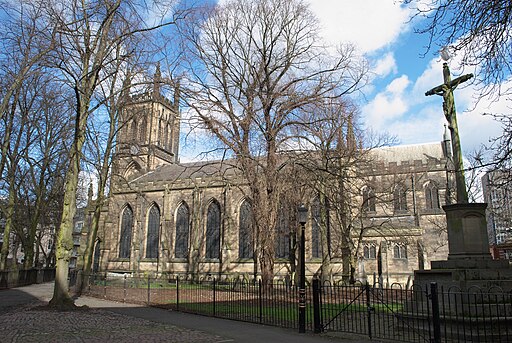On 3rd April 1881, William -- I'll call him William from now on -- was living at home with his dad Richard, on Brook Street in Syston. Less than a year later, in February 1882, William was living on Northampton Street (or does it say Southampton Street?) in Leicester, a couple of doors away from his wife-to-be, Annie Cook, and they were married at Saint George's Church in the city of Leicester. At first glance, it looks like neighbours who fell in love and married.
That's what I thought, until I remembered to count.
My grandad, Frederick Toon, was William and Annie's firstborn. He was born in Syston, Leicestershire... on 14th March, 1882. Ooops. Yes that's just two weeks after William and Annie were married. Don't ever let anyone tell you that sex-before-marriage only happened after the 1960s. It's just human nature, and by British law, any child conceived or born outside of marriage becomes "legitimate" the moment the parents marry. In case anyone, anywhere is ever still worried about that--which I hope you are not!
Here's Frederick's birth certificate:
So how did William and Annie meet, if they were not simply neighbours in Leicester?
Annie Cook was born on 29th April, 1861, the eldest child of James Cook (1835-1914) and Mary nee Litchfield (1836-1910), in the village of Slawston, on the edge of Leicestershire, Rutland and Northamptonshire, quite a way from Syston. But her father James was a waggoner, driving a horse-drawn cart, possibly delivering goods around the county. Maybe he delivered wool from the farms of rural Leicestershire and Rutland to the new, growing factories in the cities. Maybe he delivered to and from Leicester. Maybe Annie rode with him one day to see the sights, or to look for work, and met her future employer, or maybe her dad arranged the work for her, because in the 1881 census, Annie Cook, born in Slawson, is living in Syston, and working as a domestic servant and cook at Wakefield House on the Fosse Road. She is working in the household of Robert Rowley, a hosiery manufacturer who was born in Wisbech, Cambridgeshire, his wife Elizabeth, and their family of five children. I can't find the house on street maps today. (There is no street number on the census, just the name, which seems to have been forgotten. If you know, please let me know where it was, or is. I wonder if it was 99 Fosse Way, which is now a care home?)
Maybe William Toon was hired to paint the Rowley's house, and there met Annie? That would make sense... But then why were they both living on Northampton Street in Leicester at the time of their marriage, when it seems that all of William's life had been in Syston, Annie was working in Syston, and they were back there in time for Fred's birth?
Maybe Robert Rowley took care of them.
Robert Rowley had also established a business as a young man: his hosiery company was begun in Leicester, on Queen Street, in 1867. (Robert Rowley's father had moved to Leicester from Wisbech with his son, and worked in a wood yard sited on the same street as Robert Rowley's first factory. Was it a Walkers' wood yard? Because that would then connect not only with Annie's job, but also with William's mother, Mary Walker. Saving that idea for another story.)
 |
| St George's Church, Leicester (c) NotFromUtrecht CC BY-SA 3.0 via Wikimedia Commons |
Given that Robert Rowley was, by then, a very wealthy man--he left £813,931 in his estate when he died in 1936--it's quite feasible that he owned property on Northampton and/or Southampton Street, where the two could have been lodged for their wedding banns and marriage, just in time for Fred Toon's arrival. I'm only guessing... but it makes a nice story. A kind and rich benefactor for my expectant, unmarried great-greats.
(The night of 5th October 1911, the timber yard, Rowley's factory, and St Georges' church were all seriously damaged in a huge fire. The business recovered. You can read the story here.)
That's part two of the story: part three coming soon! It includes poison!!!
Click here for Part Three.




No comments:
Post a Comment